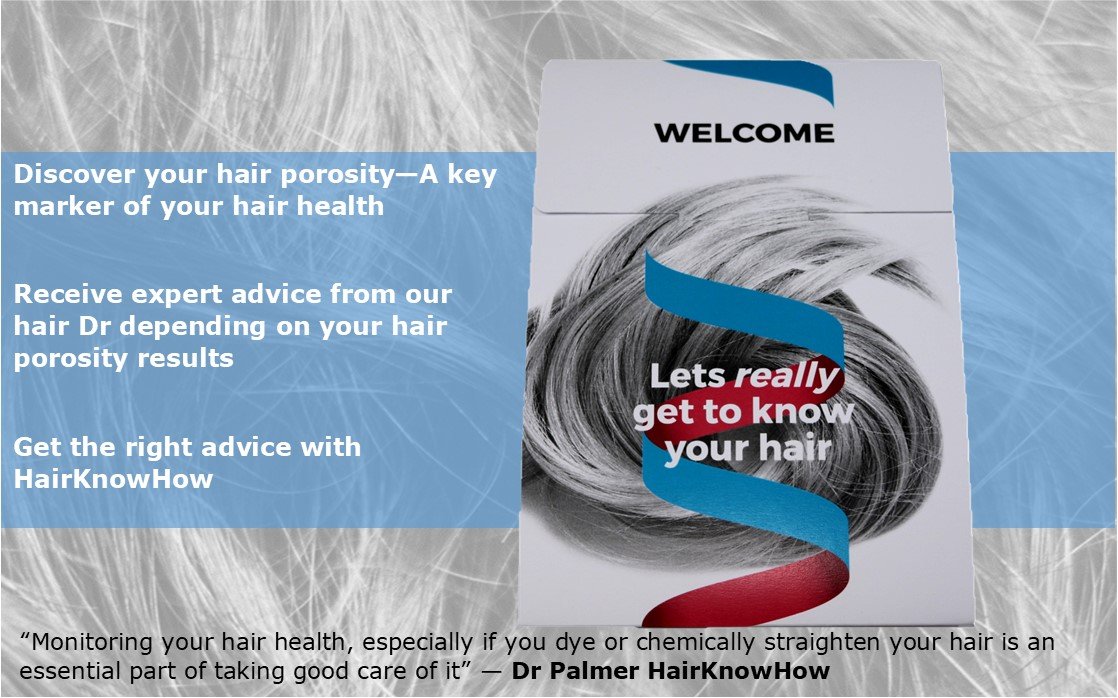Hair Elasticity Testing - Introduction
Ever wished you could assess your hair’s elasticity just like a professional? Well, now you can! Hair elasticity tests have been around for years but have recently become easier than ever with the advent of modern beauty technology.
This blog post will delve into what exactly a hair elasticity test is, how it works, and why it matters for your haircare routine. We’ll also provide some tips for selecting the best products for your hair type and maintaining a healthy scalp.
What is Hair Elasticity Test?
Your hair's elasticity refers to how much it can stretch and rebound before breaking.
When you pull an elastic band in your hand, and it bounces back, the same basic idea occurs.
It can be a useful tool for spotting potential hair care issues and is a significant factor in determining the general health of your hair.
You can test your hair's elasticity at home using a quick and easy procedure called the hair elasticity test.
The degree of curl in your hair can also be assessed using the hair elasticity test.
The test involves taking a small sample of your hair, measuring the degree of curl by straightening out the hair fibres, and then measuring how the length of the fibres changes.
We advise testing your hair at a reputable hair testing facility like HairKnowHow for a more accurate test.
Why is Hair Elasticity Test Important?
The significance of measuring hair elasticity lies in the fact that it can provide valuable insights into the health of your hair. By testing the elasticity of your hair, you can identify any potential issues, such as hidden damage leading to increased breakage, that may be affecting its health and vitality.
The elasticity of your hair can then be used to make informed decisions about your hair care routine and the products you use.
How to Conduct a Hair Elasticity Test at Home
Elasticity is a measure of how much your hair can stretch before snapping back into place, and it's a good indicator of overall health and porosity and if you need to make any changes to your hair care routine. There are a few different ways that you can test your hair's elasticity.
Luckily, you can conduct a simple elasticity test at home with just a few supplies.
Here's what you'll need:
a small section of clean, dry hair
ruler or tape measure
sharp scissors
bowl or cup
Elasticity measures how well your hair can bounce back after being stretched or pulled. Healthy hair should be able to return to its original shape after being stretched or pulled up to 30% of its length. This is an estimate and will be different depending on your hair type. Generally, if your hair breaks before it reaches this point, then it is considered damaged.
One popular method is to take a small section of dry hair and tie it into a ponytail. Use a tape measure to note the length of the ponytail. Then, gently pull on the ponytail until it stretches about 30% of its original length. If the hair snaps or breaks before it reaches this point, then it is unhealthy and needs some TLC.
Another way to test elasticity is to wet a small section of your hair and then stretch it out with your fingers. Again, use a tape measure to note the stretched length. Once you've released the tension, see how quickly your hair returns to its original state. Healthy hair should snap back into place within seconds. If it takes longer than that, or if you see any broken strands, then your hair could benefit from some extra moisture and hydration.
Ideally, your hair should be able to stretch quite far before breaking. If your results are significantly different from this, it's likely that your hair is lacking in elasticity and could use some extra TLC.
The best way to test the health of your hair is to get a HairKnowHow hair test. HairKnowHow tests thoroughly evaluate the health of your hair using multiple health indicators, i.e. porosity, cuticle heath assessments and much more. HairKnowHow test results also include expert hair advise.
Factors That Affect Hair Elasticity
Elasticity is a measure of how much your hair can stretch before breaking. The higher the elasticity, the less likely your hair is to break. Many factors can affect hair elasticity, including:
Type of hair: Curly hair is often more elastic than straight hair. This is because the curls provide a natural "spring" that helps keep the hair from breaking. This is not true elastic behaviour and is more spring-like.
Age: As we age, our hair typically becomes drier and less elastic. This is why it's important to use products that help hydrate and nourish ageing hair.
Damage: Damage from heat styling, colouring, or other chemical treatments can make hair less elastic and more prone to breakage. If you're concerned about damage, talk to your stylist about ways to minimize it.
How to Improve Hair Elasticity
If you're concerned about your hair's elasticity, there are a few things you can do to improve it. First, let's start with understanding what elasticity is.
Elasticity is a measure of how much your hair can stretch before breaking. When you pull on a strand of healthy hair, it should be able to stretch about 30 percent before breaking. If your hair stretches beyond that point, it is considered to be lacking in elasticity.
There are a number of factors that can contribute to low hair elasticity, including damage from heat styling, colouring, and chemical treatments; vitamin deficiencies; and hormonal changes. Fortunately, there are also a number of ways to improve hair elasticity.
Here are a few tips to increase hair elasticity:
Avoid heat styling and harsh chemicals as much as possible. If you do use them, be sure to use products that protect your hair from damage.
Eat a healthy diet rich in vitamins and minerals. Be sure to get enough protein, as well as vitamins A, C, and E. Also, consider taking a supplement specifically designed to support healthy hair growth.
Use deep conditioning treatments regularly. Look for products that contain keratin or collagen, which can help to strengthen the hair shaft and improve elasticity.
Avoid tight hairstyles that put a strain on the hair follicles. Wear your hair loose or in styles that allow the scalp and roots to breathe.
Understanding the Science Behind Hair Elasticity
When it comes to hair, elasticity is key. This is why many people use products like conditioners and leave-in treatments that claim to increase elasticity. But what exactly is hair elasticity? And how can you tell if your hair is healthy and elastic?
In order to understand hair elasticity, it's important to first understand the science behind it. Hair consists of three main parts: the cortex, the medulla, and the cuticle.
The cortex is the innermost layer of the hair shaft and is made up of long, protein filaments called keratin fibres.
The medulla is a central core of the hair shaft that helps protect the cortex from damage.
The cuticle is the outermost layer of the hair shaft and consists of overlapping cells that protect the cortex from environmental damage.
The strength and elasticity of your hair depend on the health of these three layers, especially the cortex.
The cortex of a hair fibre is responsible for most of the mechanical properties of hair, including its strength and texture. So if the cortex is damaged or possesses high porosity, then the hair will break more easily. But ultimately, if any of these layers are damaged, your hair will be more likely to break. That's why it's so important to use gentle haircare products and avoid using heat styling tools too often.
If you're concerned about your hair's elasticity, there are a few things you can do to test it at home. One simple test is to take a small strand of clean, dry hair and stretch it out gently. If your hair stretches more than 50% before breaking, then it has good elasticity.
The Significance of Measuring Hair Elasticity
Your hair's elasticity refers to how much it can stretch before snapping. Your hair is more elastic if the distance it stretches before breaking is higher. Your hair's health and any potential issues can be ascertained by measuring the elasticity of your hair, with any losses of elasticity being worth investigating.
Step-by-Step Guide to Testing Your Hair's Elasticity
If your hair is feeling dry, brittle, or just generally unhealthy, it might be time to test your hair's elasticity. Elasticity is a measure of how well your hair can withstand damage and stress without breaking. Here's a step-by-step guide to testing your hair's elasticity so you can get an idea of what kind of condition it's in:
Wet a small section of your hair and thoroughly comb it out.
Using both hands, hold the section of wet hair at the ends and gently pull it outward.
If your hair stretches without breaking, then it has good elasticity. If it breaks or feels very dry and brittle, then its elasticity needs some improvement.
Repeat steps 2 and 3 on different sections of wet hair all over your head to get a more accurate idea of your overall hair health.
If in doubt about your hair health. and want to get it thoroughly tested, try The Complete Hair Analysis by HairKnowHow.
Common Causes of Low Hair Elasticity
Damage to the hair cortex is one of the frequently occurring causes of poor hair elasticity. Physical or chemical damage may be the reason for this.
Physical harm can result from brushing, heated styling, and even outside influences like wind and sunlight. Over-processing with colouring, straightening, and perming procedures can result in chemical damage.
Lack of moisture, a lack of protein, and product buildup on the scalp are some additional common causes of low hair elasticity. Not drinking enough water or not using a moisturising conditioner can result in a lack of moisture. Hair that lacks enough protein may become brittle and weak.
Tips for Maintaining Healthy Hair Elasticity
It's crucial to maintain a healthy hair care routine and to protect your hair from harm if you want to keep your hair elastic.
Here are some pointers for increasing the elasticity of hair:
Do not overheat your hair.
Use sulfate-free shampoos and conditioners that are gentle.
Regularly deep condition your hair.
Restrict the use of chemicals.
Protect your hair from the sun and other environmental elements from your hair.
There are a few essential things you can do to keep your hair elastic and healthy.
When possible, stay away from using harsh chemicals and heat styling.
These two things both have the potential to harm hair follicles and cause dry, brittle hair.
Instead, choose more natural techniques like air drying or using your hair dryer's cooler setting.
To keep your hair hydrated and nourished, use a deep conditioner at least once per week.
This will keep it resilient and strong. To avoid split ends, which can make your hair more prone to breakage, get regular trims.
The Best Products for Improving Hair Elasticity
The market is flooded with haircare products that promise to increase hair elasticity, but not all of them are created equal. While some products might not work at all, others might contain harsh chemicals that could harm your hair. It's crucial to do your research and read user reviews to make sure you're using a product that will actually increase the elasticity of your hair.
Look for products that include keratin, silk protein, vitamins B5 and E, among other ingredients. These components improve the elasticity and general health of the hair by nourishing and fortifying it.
One of the best oils for hair is coconut oil. For hair, coconut oil has many known advantages. Many products, including shampoos, conditioners, and hair masks, contain coconut oil.
Last but not least, using a gentle shampoo and conditioner is one of the best things you can do for your hair. Sulfates are chemicals that many commercial products contain that will strip natural oils from your hair and leave it feeling dry and brittle. These are great for occasional cleaning, but they shouldn't be applied too frequently. To keep your hair strong and flexible, choose a shampoo and conditioner without sulphates.
Hair Elasticity Testing in a Lab
In addition to testing hair elasticity at home, a hair testing laboratory can also be used. This kind of at-home hair analysis usually gives more precise results and in-depth details about the elasticity and general health of your hair. The only provider of precise and accurate hair health testing worldwide is HairKnowHow.
There are a few different methods that can be used in a lab setting to test the elasticity of hair. A micro rheometer is a tool that is frequently used to measure the amount of force needed to deform a small sample of hair. With this information, it is then possible to determine the elastic modulus of the hair, a measurement of its stiffness.
Measuring how much hair stretches when a force is applied is another way to check its elasticity. A tool known as a strain gauge, which is fastened to the hair and gauges the deformation that takes place, can be used to accomplish this.
Using this knowledge, the hair's Young's modulus, another indicator of its stiffness, can be calculated.
Acoustic microscopy and X-ray diffraction are two less popular techniques for evaluating hair elasticity. These techniques are less frequently used in labs and are typically more expensive.
How Hair Elasticity Testing Works in a Lab
Lab testing of hair elasticity typically involves a specialised machine that measures the amount of force needed to stretch the hair to a certain length and the amount of force needed to return it to its original length. The results of this testing can then be analyzed to determine the elasticity of the hair and any factors that may be affecting it.
Elasticity is a measure of how much a material can stretch without breaking. In the case of hair, elasticity is a measure of how much force is required to break a strand of hair. The higher the elasticity, the longer the fibre gets whilst returning to its original pre-stretched length. If the fibre is stretched and does not return to its original length, then it is considered to be plastically deformed and has been permanently stretched.
The most common method is called the traction test, which involves attaching a strand of hair to a force gauge and measuring the amount of force required to break and stretch individual strands. This method is generally considered to be accurate and is used by hair research labs.
Conclusion to Hair Elasticity Testing
Finally, the hair elasticity test is a crucial instrument for determining the condition of your hair. Measuring hair elasticity can give you important knowledge about the condition of your hair and assist you in making well-informed decisions about your hair care regimen, whether you decide to conduct a quick test at home or select a more thorough lab test.
Get Expert Hair Analysis and Help
If you are interested in learning about hair testing or have a hair concern you would like to discuss, then please do get in touch. Contact the HairKnowHow Team if you have any questions.




